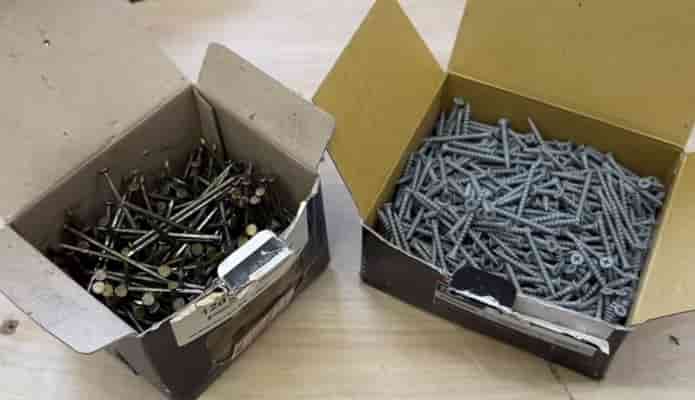Nails are preferred over screws for framing because they are quicker to install and offer greater flexibility, allowing for easier adjustments. Their shear strength is well-suited for the lateral forces encountered in framing, ensuring a sturdy and efficient construction process.
In the realm of construction, the choice between nails and screws for framing may seem like a minor detail, but it holds significant implications for the structural integrity of your project. For beginners in the carpentry domain, understanding why nails are favored over screws in certain framing applications is crucial. In this blog post, we demystify the rationale behind opting for nails and shed light on the nuanced considerations that can impact the overall success of your framing endeavors.

It is possible to use screws instead of nails for framing, but there are a few things to consider before making the switch. Screws tend to loosen over time, while nails hold more firmly in place. Additionally, screws can be harder to countersink than nails, leading to an uneven surface. Ultimately, it's up to the builder or contractor to decide which fastener works best for their project.
Related: Drywall Screw Guns
Do screws hold tighter than nails?
It depends on what you're screwing/nailing into. If you're screwing into a hard surface like wood, screws will hold tighter than nails. If you're nailing into a soft surface like drywall, nails will hold tighter than screws.
Related: What Size Nails for Framing?
Why can you not use screws for framing?
There are a few reasons why screws are not typically used for framing:
- Screws are not as strong as nails and can easily pull out of the wood.
- It is difficult to get screws to stay in place when you are trying to attach two pieces of wood; nails will usually grip the wood better.
- Using screws instead of nails can make it harder to disassemble a frame later on since you need to remove each screw individually.
It is generally recommended that you use nails for framing projects for these reasons.
Why use nails instead of screws for framing?
If you're a contractor or builder, you know that nails and screws are important fasteners. But which one is better for framing? Here are 10 reasons to use nails instead of screws for your next framing project:
- Nails provide a stronger connection than screws. This is because nails grip the wood better and are less likely to loosen over time.
- Nails are easier to remove than screws. This can be helpful if you ever need to change your framing.
- Nails are less likely to strip the wood. This can happen with screws, particularly if they are over-tightened.
- Nails are less expensive than screws. This can be helpful when working on a budget.
- Nails are more forgiving than screws. This means that they are less likely to cause damage if they are not installed perfectly.
- Nails are more aesthetically pleasing than screws. This is because they do not leave behind visible holes.
- Nails can be painted over. This can be helpful if you want to match your trim color or hide them for a more polished look.
- Nails are less likely to cause splintering. This can happen when using screws, particularly if the wood is not pre-drilled.
- Nails will not mar the surface of your wood. This can happen with screws, which can leave behind unsightly marks.
- Nails provide a more traditional look. This can be important if you are working on a historic restoration or reproduction.
Nails vs Screws for Framing: Which one is better?
There are two main types of fasteners used for framing: nails and screws. Each has its advantages and disadvantages that you should consider before deciding which one to use for your project.
Nails are the traditional choice for framing, and they have some definite advantages. They're less likely to loosen over time, so they're ideal for projects that experience a lot of vibration or movement. They're also easier to drive into wood, so you don't need much force to get them started.
Related: How to Remove Sunken Nails from Wood? [5 Methods]
However, screws have some advantages over nails as well. They're less likely to split the wood to be used in thinner pieces of lumber. And because they bite into the wood, they're less likely to work themselves loose over time.
Related: How to Remove a Stripped Screw?
So which one should you use for your project? It depends on your specific needs. For example, nails are the way to go if you need a very strong fastener that won't loosen. But if you're working with thinner lumber or you need a fastener that's less likely to split the wood, screws are the better choice.
Related: How to Repair Exposed Nails on Roof with 6 Simple Steps
See if nails or screws work better for framing in this video:
Final Words
Nails are better for framing than screws because they create a tighter bond and don't strip the wood as easily. When you're framing with nails, it's important to use a hammer that's the right weight for the job; using too much or too little force can cause problems. If you're not comfortable using a hammer, many other tools can drive nails, such as pneumatic nailers and battery-powered nail guns. However, nailing your frames together is easy to ensure a strong, sturdy finished product with the right tools and techniques. Have you tried framing with nails? What tips do you have to share?
Related:
How to Put a Tarp on a Roof Without Nails? [2 Popular Methods]
How to Remove Dried Liquid Nails from Concrete without Damaging It